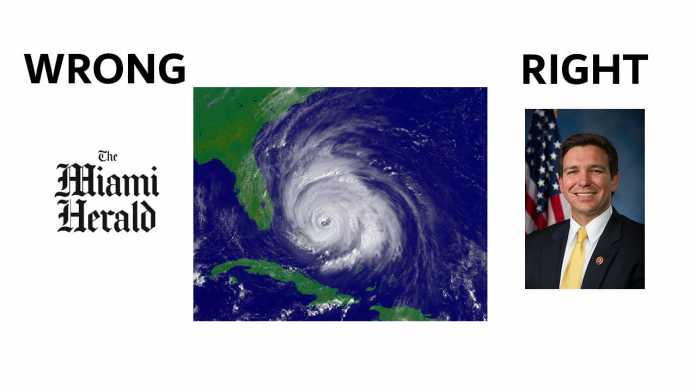Today we find a Miami Herald article in which the newspaper complains about Gov. Ron DeSantis’s response to climate change. DeSantis’s response to the threat from hurricanes and rising seas is to adapt by enhancing infrastructure rather than reducing greenhouse gas emissions. Data does not show rising carbon dioxide emissions are making hurricanes worse or making seas rise at a faster than they have historically. As a result, because seas will rise and hurricanes will strike Florida, regardless of greenhouse gas emissions, DeSantis is right to focus on minimizing the damage either can do to the state’s people and businesses.
The Miami Herald article, titled “On climate change, DeSantis focuses on infrastructure while ignoring emissions,” acknowledges DeSanitis is working to harden Florida’s communities to natural disasters and extreme weather events.
“Since his election in November 2018, DeSantis is making good on some of his environmental promises, including what he likes to call “resilience,” a new buzzword for climate adaptation,” says the Herald. “[T]he $1 billion Resilient Florida plan he announced in January could be a first step toward helping some communities pay for adaptation.”
But the paper then complains, “DeSantis has done almost nothing to put Florida on a path to scaling back the state’s heavy reliance on fossil fuels.”
This complaint is off the mark since there is no evidence scaling back Florida’s emissions from fossil fuels will do anything to prevent damage from hurricanes or rising seas.
According to data from the U.N. Intergovernmental Panel on Climate Change (IPCC) and the U.S. National Oceanic and Atmospheric Administration (NOAA) hurricanes are neither more frequent nor more severe than in the past. Also, IPCC and NOAA data show no acceleration in sea level rise.
As discussed in Climate at a Glance: Hurricanes the IPCC’s 2018 “Interim Report” observes there is “only low confidence for the attribution of any detectable changes in tropical cyclone activity to anthropogenic influences.” The U.N. observation reflects hurricane and tropical storm data in the Figure, below.
Figure : This figure shows global hurricane and tropical cyclone activity are not increasing. Source: Global Tropical Cyclone Activity, Dr. Ryan N. Maue, accessed March 3, 2020, http://climatlas.com/tropical/frequency_12months.png
Indeed, hurricane impacts on the United States have recently been at an all-time low. The United States went more than a decade, from 2005 through 2017, without a major hurricane measuring Category 3 or higher making landfall, which is the longest such period in recorded history. The United States also recently experienced the fewest number of hurricane strikes in any eight-year period, 2009 through 2017, since records have been kept. Florida recently concluded an 11-year period, from 2005 through 2016, without a landfalling hurricane of any size—the longest such period in recorded history.
Concerning rising seas, NASA and NOAA satellite instruments, show sea level is rising at a mere 3 millimeters per year, which is just under one foot per century. This rate is little if any faster than the pace of sea-level rise recorded since the middle of the 1800s. This means there is no evidence increasing human carbon dioxide emissions since the 1950s have appreciably changed the rate of sea level rise.
Data reported in a study produced by the Non-governmental International Panel on Climate Change shows ocean levels are rising slower in some parts of Florida than they are on average around the world. For example, on Florida’s northern Gulf Coast, St. Petersburg’s measured sea level rise is approximately 10.7 inches per century. At Fernandina Beach, on Florida’s Northern Atlantic coast, seas are rising at an average rate of just 8.3 inches per century. Some cities in Florida, like Miami, may be experiencing faster than average rates of sea level rise. However, as is true elsewhere this is occurring around the globe, this is almost entirely due to local conditions like land subsidence due to compaction and sinking from water withdrawals from underground aquifers.
Even if greenhouse gas emissions were causing more, or more intense hurricanes, and faster rising seas, there is no evidence sharply curtailing carbon dioxide emissions in Florida would reduce these problems. Florida’s share of U.S. carbon dioxide emissions is 3.75 percent. The United States share of world carbon dioxide emissions is 11 percent, meaning if Florida ended all its carbon dioxide emissions tomorrow, it would reduce world emissions by approximately 1/3 of 1 percent. The temperature increase averted by this amount of emissions reduction is too small to measure accurately. As a result, Florida’s emissions reduction would prevent no measurable sea level rise, nor would it reduce the number or severity of hurricanes.
Gov. Ron DeSantis’s response to climate change the response most likely to reduce harm from future natural disasters and extreme weather events: better infrastructure and adaptation. The Miami Herald should applaud DeSantis for focusing the states’ limited resources on the response to climate change most likely to produce tangible benefits. Instead the paper is haranguing him for not virtue signaling by forcing the state’s residents and businesses to make ineffective emission reductions.


















Recent legislation in the State of Hawaii requires that use of fossil fuels be terminated by 2035.
Using your analysis, that should reduce world emissions by about 1/8 of 1 percent. For what? The beautiful Hawaiian landscape will be littered with bird/bat killing windmills, ugly solar panel farms and dead batteries that are not biodegradable and are dangerously combustible. This change in world emissions will result in no change to Hawaiian weather or sea level. The Green New Deal is insanity.